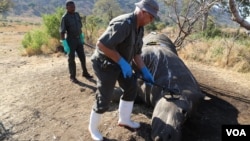South Africa's flagship Kruger Park, home to the world's largest population of rhinos, is on the frontlines of a poaching war. The government has announced a plan to move up to 500 rhinos in an attempt to increase their population and counter a poaching epidemic that has seen hundreds of rhinos killed for their horns just this year. The relocations are just part of a multi-pronged approach to save the animals. But in the face of the lucrative illegal horn market - is it enough?
Two rhinos graze on the tall grass in the Lower Sabie region of Kruger National Park, unaware of their bloated cousin lying dead just a meter away. Vultures eye the body greedily from a nearby tree while an orchestra of flies feast on the latest victim of poaching.
An investigator from the South Africa National Parks Crime Unit gingerly steps around the butchered animal to collect evidence - in the hopes of catching the perpetrators. A metal detector locates the bullet inside the body before the team dissects the carcass.
Poachers shot the rhino and broke it’s back with an axe to immobilize it before gouging out its horns - the prize they hope to sell to Asians who view rhino horn as a status symbol or erroneously think it is a healing agent.
Lawrence Baloi, a ranger of the Lower Sabie, knows how easy it is for young men to be coaxed into the hunt.
“They are clever… if someone got a rhino, it’s like a big boss, mega big party, all the ladies - they rise to him. So, he is sending information that: guys, [while] you [are] busy sitting here, we are making money there. Follow me next. That’s why those groups escalate every day,” said Baloi.
South Africa has grappled with a wave of poaching that has seen nearly 700 rhinos killed since January, with 458 slaughtered in Kruger Park alone.
Relocation plan
The government plans to relocate up to 500 rhinos to other state-owned and private parks. Nearby countries, Botswana and Zambia, might also be considered as safe havens.
South Africa has relocated 1,450 animals from Kruger over the past 15 years to manage herd populations.
The colossal operation involves tracking the animals in the rugged bush, darting them with tranquilizers from helicopters and then moving them in customized trucks.
“The whole success of rhino survival, in Africa at least, has pretty much been based on the fact they were translocated to different areas. With the threat of poaching, we want to create opportunities where they can breed successfully and quickly, so we can off-set some of the poaching losses and in time, maximize on growth,” said Kruger’s head vet, Markus Hofmeyr.
Lucrative trade
Relocating rhinos might disperse the poachers’ targets, but SAN Park’s teams know it won’t be enough to put off criminal networks behind the lucrative trade. Only 400 rangers have the task of patrolling the park’s two million hectares.
“The poachers and the syndicates are driven to be successful because the reward is so great. The tactics of the poachers evolve incredibly fast… it is incumbent on us to adapt as fast as they do,” said Bruce Leslie, part of the Special Operations team.
In 2010, poachers could get $7,500 for a set of horns. But now they get much more, according to Kobus de Wed of the Crime Investigation Unit.
“A lot of poachers were fatally wounded, the poachers decided that they didn't want to be paid as hunting cells. They want to be paid by kilogram, in weight,” said de Web.
A large horn can now fetch a maximum price of $120,000 by weight.
Riches like these have attracted criminal networks operating from southern Africa to China. So while relocating and protecting rhinos might spread the risk or outfox a few poachers, experts say it will not be enough until international coordination follows the money trail and brings down the rhino horn kingpins.






